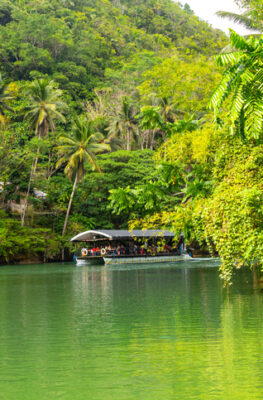Published on April 3, 2018
As we’ve explained before, Southeast Asia loves strange things: and that applies to the food as well. We asked several blogger travelers what strange dishes they encountered on their travels, and we got a smorgasbord of quirky answers.
In Cambodia and Malaysia, Bugs on the Menu
“I’ve tried many weird foods around the world, smelly durian in Thailand, the best turtle soup in Singapore, snake in China… you name it,” Invest Travel Play‘s Chloe Lin (Facebook|Instagram) tells us. “But eating insects is something I’ve never imagined myself doing!”
That’s all part of the experience in Cambodia, where certain insects are an indispensable part of the menu. For snacks, Chloe’s Cambodian friend delivered: “I didn’t expect she would come back with a bag of fried crickets!” Seeing her friend “happily eating it as if it was the most delicious snack on earth,” Chloe decided to try it for herself.
“It was… super crispy!” she recalls. “I didn’t even feel like I was eating an insect. It was so delicious and crispy, much better than potato chips!”
Time Travel Turtle‘s Michael Turtle (Facebook|Twitter|Instagram) discovered tarantulas in Romdeng Restaurant in Phnom Penh. “They’re terrifying when they’re alive and, I can tell you, they’re still pretty scary when they’re dead,” Michael says. “The tarantulas on my plate may not have been moving but that didn’t make me any less queasy as I reached for the first one.”
Romdeng’s menu combines traditional Cambodian dishes with some rather unusual picks: among them “three fried tarantulas, served with lime and pepper sauce,” Michael tells us.
“As I put my fork into one of the spiders, I heard a cracking like a shell breaking. As I bit into the first legs, they broke easily and tasted a bit like a prawn tail. After a few chews, I swallowed them down and was pleasantly surprised.
“The body, though. That was different.”
Michael decided to dispose of the thorax in one bite, and found it hard going. “It tasted kind of dirty, like an insect,” he recalls. “The worst thing, though, was that it was extremely hard to chew – the more I did, the more it turned into a hardened little ball. Eventually I just had to swallow it whole.”
Tarantula-eating should still be on your bucket list, says Michael, as long as you keep your expectations low. “Give it a go – and be thankful you have the lime and pepper sauce on the side!”
Eat Cook Explore‘s May Chong (Twitter|Facebook|Instagram) tells us that a different invertebrate graces plates in the state of Sabah in Malaysia.
Meet butod: “The sago grub or the larvae of the sago palm weevil, a species of snout beetle,” May says. “These cream coloured, fat, squirming pods look like fat caterpillars. They are a good protein source, highly nutritious and are found in the sago palm tree.”
While their adult forms are useless, their larval forms are a local delicacy. “You have to be quick to find them before they turn into beetles,” May says. “The more gung ho will pick them straight from the tree and eat it live (without the head). It’s quite crunchy and tastes a bit like sweet coconut milk.”
Sabahans love to eat butod “stir-fried; [it’s] popular as a bar snack,” May explains. “Others will grill or roast them and remove the hard and spiny parts before eating.”
In Singapore and Laos, Heady Concoctions
From Singapore, Rambling Feet‘s Nicholas Lim (Facebook|Twitter|Instagram) touts a strange, processed nut that has become an unlikely Peranakan food favorite. “Buah keluak,” Nicholas tells us, “comes to you as black, flat nuts peeking out of a china bowl of chicken stew.
“Each seed, the size of a golf-ball, has a hole in its side, revealing an equally-black paste that stains everything in the dish a dirty brown,” Nicholas says. “It’s hard to believe something so unappetising is a popular Peranakan delicacy that you can try on a visit to Singapore. However, just wait until you hear what it takes to prepare it.”
Buah keluak comes from the kepayang tree (pangium edule), whose nuts contain deadly levels of cyanide. “Workers have to boil them in water after harvesting, then bury them in the ground with banana leaves and ash for forty days,” Nicholas says. “Even though they are sold like this, they still need to be scrubbed and soaked for up to a week with several changes of water.
“The whole process reduces the off-white flesh of the nut to a black paste,” Nicholas says. “Who discovered this process, and what on earth could have motivated them?”
However they arrived at the final product, one can’t deny the intense flavor it gives out. “Taste a spoonful of this sinister-looking mixture and an earthy bitterness stands out,” Nicholas says. “The sambal adds heat, lemongrass and tamarind. It recalls a dark chocolate mole – rich, complex, and most importantly, delicious.
“Who cares that it’s not ‘Instagrammable’?”
Allan Wilson of Live Less Ordinary (Twitter|Facebook|Instagram) loves indulging weirdness while traveling in Southeast Asia, up to and including Lao food and alcoholic drinks. “One of the less palatable liquors would have to be a local liquor in Laos known as Lao-Lao, often dubbed as the ‘Cheapest Alcohol in the World’, which locals would happily hand you for free to see if you can handle it,” Allan tells us.
Don’t let the strange appearance fool you: it’s a rice whiskey made in Lao home distilleries. “The roughly 40% proof alcohol is made through steamed distillation using sticky rice hulls and crumbles of yeast balls, and is then drank simply as a rice whisky, or alternatively infused with ‘medicinal’ ingredients such as herbs, roots and spices, or possibly lizards, snakes and scorpions,” Allan explains.
You’ll find these infused jars of Lao-Lao in many local markets, often bottled as tiny tourist trinkets. “The practice of infusing alcohol is still continued locally, where the effects are said to enhance power, strength and libido,” Allan explains. “Although I can’t say any of this worked for me – house lizard infused rice whisky tastes a bit like liquid stale bread.”
In Vietnam and Malaysia, Fowl Play
Teresa Gomez of Brogan Abroad (Twitter|Facebook|Instagram) prioritizes food tours when she visits a new place, and her trip to Ho Chi Minh City in Vietnam was no different.
“I was kind of hoping that one particular local delicacy I’d heard of would be included in the tour, but at the same time I wasn’t sure whether I’d be able to eat it,” Teresa tells us. “I’m talking about balut, boiled fertilised duck egg.”
Her wish was granted. Balut, popular in both Vietnam and the Philippines, is a fertilized, semi-formed duck embryo in the shell. “It gets served just like a regular boiled egg in the shell, so you crack it open and normally eat it straight from the shell but we put it into a little bowl,” Teresa tells us.
“I was surprised to see the developing duck embryo so defined inside, certainly not the most appealing looking dish I’ve ever tried, but I took a little spoon and tucked in,” she continues. “It tasted surprisingly like a normal boiled egg, but you dip into this beautiful peppery sauce that makes it quite special.”
In search of Kuala Lumpur’s best food experiences, the Roaming Fork‘s Markus Kampl (Facebook|Twitter|Instagram) came across a unique way to serve up some of the little used parts of a duck.
“If you find yourself in Kuala Lumpur, and are looking to expand your enjoyment of eating duck, then I recommend visiting the famed Sze Ngan Chye cart in Petaling Street,” Markus tells us. “For the last 50 years, the Choong family have consistently been serving up some incredibly tasty and moist salted roast duck.
“They also offer, for the more adventurous, an intriguing little parcel made up of duck’s feet and liver, wrapped up using the bird’s intestines, then cooked in a salty and sweet sauce,” he says.
The parcel is flavorful and quite surprisingly cheap. “The rich flavour of the sauce infuses the parcel, and although the succulent flavour profile doesn’t change with each bite, the texture does as you move through the soft liver, the feet, and the chewy intestines,” Markus says. “It was pleasing to see the vendor using the excess parts of the duck, and at a little less that one dollar, it is worth an early trip to Petaling Street.”
In the Philippines and Thailand, Some Odd Street Foods
Southeast Asia’s outdoor markets are your best bet for odd eats, as Campbell and Alya of Stingy Nomads (Instagram|Facebook|Twitter) found out for themselves in Bangkok, Thailand.
“Amphawa floating market in Thailand is one of our favourite Asian markets; it has very nice local vibe,” the traveling couple tell us. “I’m a big fan of seafood and this market was a real paradise for me – shrimps, calamari, prawns, fish, mussels and squid. The strangest thing here for me was fried squid eggs.”
Grilled squid on skewers come stuffed with fried squid eggs: the latter comes as a surprise for first-time eaters. “It looked quite nice till we were told what was inside,” Alya recalls. “The eggs tasted strange and chewing them wasn’t very pleasant. We struggled to finish our squid and after decided to stick to delicacies like prawns and calamari.”
“You’ve heard of some pretty wacky foods here in Southeast Asia – heck, I’ve probably tried half of this list,” Live Travel Teach‘s Mike Still (Facebook|Twitter|Instagram) says. “The absolute strangest thing that I’ve eaten in Southeast Asia were skewered chicken heads!”
Mike and a friend were riding a motorbike around Cebu and neglected to plan for dinner. The resort’s food was expensive; Mike and company decided to find something cheap along the route, which was sadly some way off the beaten path.
“When we saw a line of locals standing around a lady with a bbq we decided it didn’t matter what she was cooking,” Mike recalls. “The grill was full of skewers and with a few animal noises and hand motions we understood that we could pick pork or chicken and ordered 2 skewers each.”
Getting more adventurous, Mike asked the host whatever she recommended. One bite revealed the truth: “With one crunch I instantly realized that we were in fact eating a chicken head! The skull crunched beneath my teeth and I think I felt the eye pop but the beak remained fully intact.
“I grabbed the beak with my fingers and swallowed the rest in what will likely remain my strangest food experience ever!”
Other Quirky Foods in Southeast Asia
Ambuyat in Brunei. This goopy Bruneian delicacy is made by mixing hot water into starch taken from the inner trunk of the sago palm. Locals never eat it straight: you must roll a morsel-sized blob of ambuyat around the prongs of a chandas (a large bamboo fork), before dipping it into a variety of sauces made from local fruits. Find out more in this list of quintessential Southeast Asian foods.
Laphet in Myanmar. Tea-crazy Myanmar prepares tea leaves for eating, too: the salad known as laphet thoke combines fermented tea leaves with assorted local greens, nuts and the occasional animal protein to create something unique. The fermentation process softens and flavors the tea leaves; and the other ingredients (including fried beans, toasted sesame seeds, roasted peanuts) round out the whole experience. Read about ASEAN culinary delicacies to find out more.






